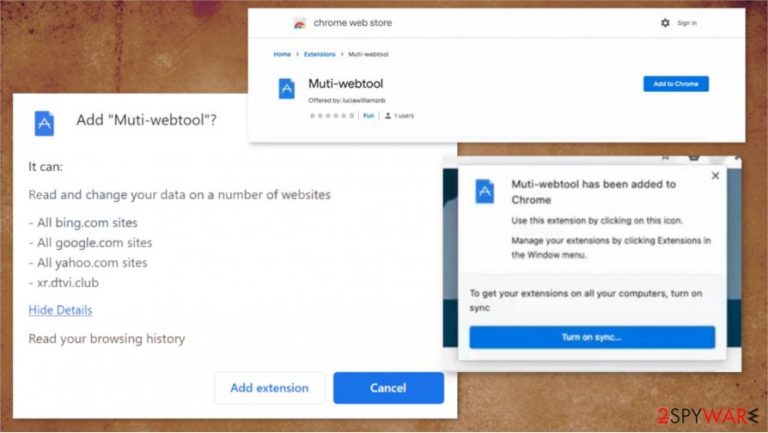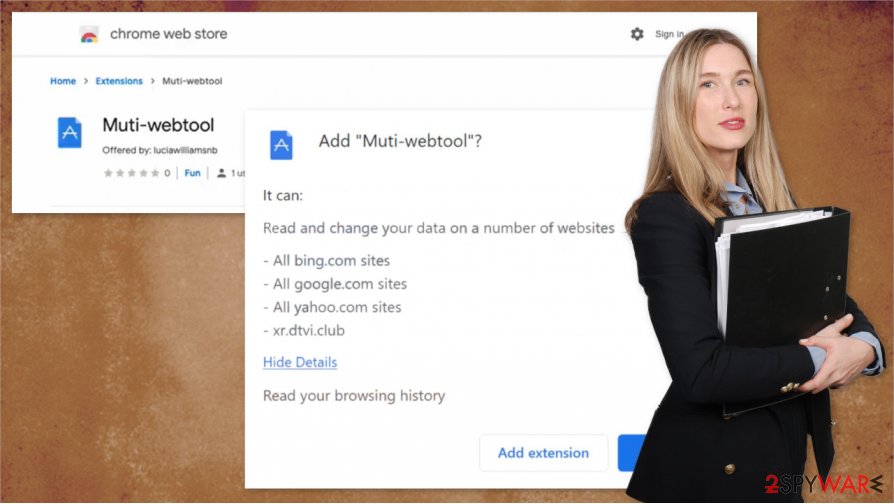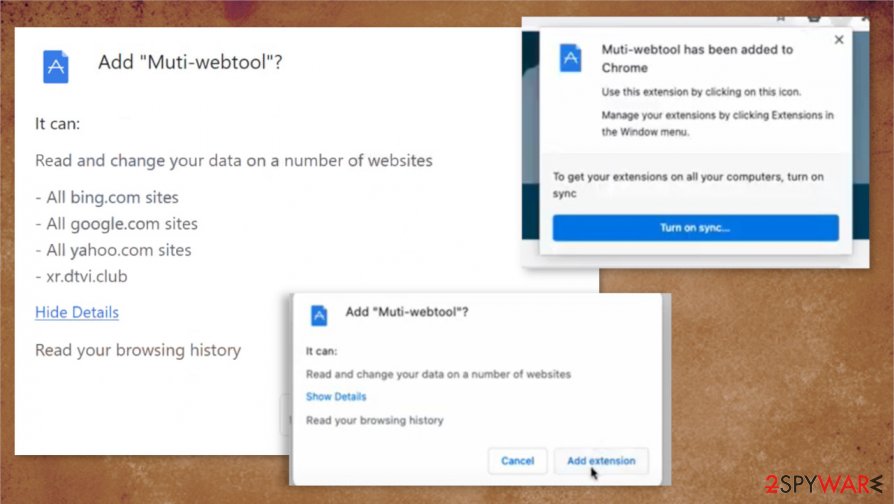Muti-Webtool (Removal Guide) - Free Instructions
Muti-Webtool Removal Guide
What is Muti-Webtool?
Muti-Webtool is the search hijacker that triggers particular changes on the web browser, so the traffic is controlled

Muti-Webtool – the intruder that tries to affect time online by redirecting to other search engines and showing shady advertisements. The potentially unwanted program comes out of nowhere in most cases but also can get installed by the user willingly when promotional pages, ads, and other materials are convincing enough. Developers of these browser-based threats rely on sponsored content, commercial sites, and other techniques that allow distributing their products around with the help of others. This is why PUPs[1] have a bad reputation for using software bundling methods. You can eliminate this program/browser add-on freely, and you even SHOULD do so if the application got installed behind your back without any permissions. There is nothing valuable about such rogue software.
| Name | Muti-Webtool |
|---|---|
| Type | Browser hijacker, potentially unwanted program |
| Distribution | Software bundle packages, deceptive ads, fake update prompts, promotional content |
| Symptoms | Unknown extension or application is installed on the system; homepage and new tab address are set to Tailsearch or different engine; search results are filled with sponsored links and ads, banners that trigger more redirects |
| Risks | Installation of other potentially unwanted programs, privacy risks due to information gathering practices, financial losses |
| Removal | You can remove Muti-Webtool by scanning the computer with powerful anti-malware |
| Optional steps | Computer infections can cause significant damage to system files or disrupt normal settings. So perform a full system scan with FortectIntego repair software that can help with virus damage and system issues |
Muti-Webtool is the redirect virus or search engine hijacker that affects the speed of the system and the internet in general significantly. it mainly aims to reroute every online search on the web browser, so the user is exposed to unwanted material and can generate views, page visits on sponsored third-party pages.
The main issue with the Muti-Webtool virus is its relation to additional programs and possibly dangerous applications. The main redirecting site that this app reroutes to is Tailsearch.com. This is the intruder family that also includes:
You should move to Muti-Webtool removal right away because any PUPs can lead to additional installations of shady system programs and malicious applications that affect the system significantly. You need to rely on tools like SpyHunter 5Combo Cleaner or Malwarebytes and properly check the machine for any threats or possibly malicious applications.
Running a security program or anti-malware tool on the system not only ensures that you can remove Muti-Webtool but also improves the performance of the infected machine when all the potential threats get eliminated completely from the system. You can then check for changes on the web browser and repair any damage.

Muti-Webtool is not malicious or dangerous in any way, but you need to pay attention to the fact that PUPs show third-party content[2] that the developers and browser hijacker creators are not responsible for. These issues create privacy issues, identity theft, and other problems that experts[3] always note about.
Muti-Webtool adds itself as an extension on the browser, and Google Chrome, Internet Explorer, Safari, or any other browsers become difficult to use normally. Besides those changes to the homepage, search engine, and new tab, this intruder can also alter preferences of pages, add other applications, toolbars.
Make sure to eliminate the PUP itself and repair any settings that Muti-Webtool triggers to change behind your back. You can run FortectIntego as a system optimization and recovery tool that repairs altered files, functions, disabled programs. You might need some help with browser resetting, so the guide below should help you with these issues.

Avoid PUP infiltrations by relying on proper sources
You can suffer from such cyber threats as browser hijackers, adware, and general PUPs when you do not pay attention to details that are more important than you may think. Free download sites and p2p services, torrents, pirating platforms might be convenient, but that is not safe nor legal.
Stay away from such pages and make sure to rely on creators, developers of the applications that you want to get, download, and use. This is the best way and the safest method that ensures that software bundling or additional techniques are not used to spread PUPs to your system. Always go for the Advanced or Custom installation option and control what apps you get from the internet.
Make sure to eliminate any traces of the Muti-Webtool PUP
Don't forget about the issue that the intruder creates when you remove Muti-Webtool from the machine – registry and startup file alterations. You can terminate the intruder with anti-malware tools and make the machine virus-free again, but you need to repair those alterations if you want to use the PC normally again.
Muti-Webtool removal gives the best results and the quickest when you rely on security tools, anti-malware apps that use a trustworthy AV engine database. Also, you should get a program that repairs affected files and altered functions. You need to still do manual changes on web browsers, so save time with professional system tools.
You may remove virus damage with a help of FortectIntego. SpyHunter 5Combo Cleaner and Malwarebytes are recommended to detect potentially unwanted programs and viruses with all their files and registry entries that are related to them.
Getting rid of Muti-Webtool. Follow these steps
Uninstall from Windows
Repair the machine by eliminating Muti-Webtool
Instructions for Windows 10/8 machines:
- Enter Control Panel into Windows search box and hit Enter or click on the search result.
- Under Programs, select Uninstall a program.

- From the list, find the entry of the suspicious program.
- Right-click on the application and select Uninstall.
- If User Account Control shows up, click Yes.
- Wait till uninstallation process is complete and click OK.

If you are Windows 7/XP user, proceed with the following instructions:
- Click on Windows Start > Control Panel located on the right pane (if you are Windows XP user, click on Add/Remove Programs).
- In Control Panel, select Programs > Uninstall a program.

- Pick the unwanted application by clicking on it once.
- At the top, click Uninstall/Change.
- In the confirmation prompt, pick Yes.
- Click OK once the removal process is finished.
Delete from macOS
Remove items from Applications folder:
- From the menu bar, select Go > Applications.
- In the Applications folder, look for all related entries.
- Click on the app and drag it to Trash (or right-click and pick Move to Trash)

To fully remove an unwanted app, you need to access Application Support, LaunchAgents, and LaunchDaemons folders and delete relevant files:
- Select Go > Go to Folder.
- Enter /Library/Application Support and click Go or press Enter.
- In the Application Support folder, look for any dubious entries and then delete them.
- Now enter /Library/LaunchAgents and /Library/LaunchDaemons folders the same way and terminate all the related .plist files.

Remove from Microsoft Edge
Delete unwanted extensions from MS Edge:
- Select Menu (three horizontal dots at the top-right of the browser window) and pick Extensions.
- From the list, pick the extension and click on the Gear icon.
- Click on Uninstall at the bottom.

Clear cookies and other browser data:
- Click on the Menu (three horizontal dots at the top-right of the browser window) and select Privacy & security.
- Under Clear browsing data, pick Choose what to clear.
- Select everything (apart from passwords, although you might want to include Media licenses as well, if applicable) and click on Clear.

Restore new tab and homepage settings:
- Click the menu icon and choose Settings.
- Then find On startup section.
- Click Disable if you found any suspicious domain.
Reset MS Edge if the above steps did not work:
- Press on Ctrl + Shift + Esc to open Task Manager.
- Click on More details arrow at the bottom of the window.
- Select Details tab.
- Now scroll down and locate every entry with Microsoft Edge name in it. Right-click on each of them and select End Task to stop MS Edge from running.

If this solution failed to help you, you need to use an advanced Edge reset method. Note that you need to backup your data before proceeding.
- Find the following folder on your computer: C:\\Users\\%username%\\AppData\\Local\\Packages\\Microsoft.MicrosoftEdge_8wekyb3d8bbwe.
- Press Ctrl + A on your keyboard to select all folders.
- Right-click on them and pick Delete

- Now right-click on the Start button and pick Windows PowerShell (Admin).
- When the new window opens, copy and paste the following command, and then press Enter:
Get-AppXPackage -AllUsers -Name Microsoft.MicrosoftEdge | Foreach {Add-AppxPackage -DisableDevelopmentMode -Register “$($_.InstallLocation)\\AppXManifest.xml” -Verbose

Instructions for Chromium-based Edge
Delete extensions from MS Edge (Chromium):
- Open Edge and click select Settings > Extensions.
- Delete unwanted extensions by clicking Remove.

Clear cache and site data:
- Click on Menu and go to Settings.
- Select Privacy, search and services.
- Under Clear browsing data, pick Choose what to clear.
- Under Time range, pick All time.
- Select Clear now.

Reset Chromium-based MS Edge:
- Click on Menu and select Settings.
- On the left side, pick Reset settings.
- Select Restore settings to their default values.
- Confirm with Reset.

Remove from Mozilla Firefox (FF)
Remove dangerous extensions:
- Open Mozilla Firefox browser and click on the Menu (three horizontal lines at the top-right of the window).
- Select Add-ons.
- In here, select unwanted plugin and click Remove.

Reset the homepage:
- Click three horizontal lines at the top right corner to open the menu.
- Choose Options.
- Under Home options, enter your preferred site that will open every time you newly open the Mozilla Firefox.
Clear cookies and site data:
- Click Menu and pick Settings.
- Go to Privacy & Security section.
- Scroll down to locate Cookies and Site Data.
- Click on Clear Data…
- Select Cookies and Site Data, as well as Cached Web Content and press Clear.

Reset Mozilla Firefox
If clearing the browser as explained above did not help, reset Mozilla Firefox:
- Open Mozilla Firefox browser and click the Menu.
- Go to Help and then choose Troubleshooting Information.

- Under Give Firefox a tune up section, click on Refresh Firefox…
- Once the pop-up shows up, confirm the action by pressing on Refresh Firefox.

Remove from Google Chrome
Make sure to restore settings on the browser. You can restore it to default fully
Delete malicious extensions from Google Chrome:
- Open Google Chrome, click on the Menu (three vertical dots at the top-right corner) and select More tools > Extensions.
- In the newly opened window, you will see all the installed extensions. Uninstall all the suspicious plugins that might be related to the unwanted program by clicking Remove.

Clear cache and web data from Chrome:
- Click on Menu and pick Settings.
- Under Privacy and security, select Clear browsing data.
- Select Browsing history, Cookies and other site data, as well as Cached images and files.
- Click Clear data.

Change your homepage:
- Click menu and choose Settings.
- Look for a suspicious site in the On startup section.
- Click on Open a specific or set of pages and click on three dots to find the Remove option.
Reset Google Chrome:
If the previous methods did not help you, reset Google Chrome to eliminate all the unwanted components:
- Click on Menu and select Settings.
- In the Settings, scroll down and click Advanced.
- Scroll down and locate Reset and clean up section.
- Now click Restore settings to their original defaults.
- Confirm with Reset settings.

Delete from Safari
Remove unwanted extensions from Safari:
- Click Safari > Preferences…
- In the new window, pick Extensions.
- Select the unwanted extension and select Uninstall.

Clear cookies and other website data from Safari:
- Click Safari > Clear History…
- From the drop-down menu under Clear, pick all history.
- Confirm with Clear History.

Reset Safari if the above-mentioned steps did not help you:
- Click Safari > Preferences…
- Go to Advanced tab.
- Tick the Show Develop menu in menu bar.
- From the menu bar, click Develop, and then select Empty Caches.

After uninstalling this potentially unwanted program (PUP) and fixing each of your web browsers, we recommend you to scan your PC system with a reputable anti-spyware. This will help you to get rid of Muti-Webtool registry traces and will also identify related parasites or possible malware infections on your computer. For that you can use our top-rated malware remover: FortectIntego, SpyHunter 5Combo Cleaner or Malwarebytes.
How to prevent from getting browser hijacker
Choose a proper web browser and improve your safety with a VPN tool
Online spying has got momentum in recent years and people are getting more and more interested in how to protect their privacy online. One of the basic means to add a layer of security – choose the most private and secure web browser. Although web browsers can't grant full privacy protection and security, some of them are much better at sandboxing, HTTPS upgrading, active content blocking, tracking blocking, phishing protection, and similar privacy-oriented features. However, if you want true anonymity, we suggest you employ a powerful Private Internet Access VPN – it can encrypt all the traffic that comes and goes out of your computer, preventing tracking completely.
Lost your files? Use data recovery software
While some files located on any computer are replaceable or useless, others can be extremely valuable. Family photos, work documents, school projects – these are types of files that we don't want to lose. Unfortunately, there are many ways how unexpected data loss can occur: power cuts, Blue Screen of Death errors, hardware failures, crypto-malware attack, or even accidental deletion.
To ensure that all the files remain intact, you should prepare regular data backups. You can choose cloud-based or physical copies you could restore from later in case of a disaster. If your backups were lost as well or you never bothered to prepare any, Data Recovery Pro can be your only hope to retrieve your invaluable files.
- ^ Potentially unwanted program. Wikipedia. The free encyclopedia.
- ^ What is Malvertising?. Forcepoint. Cyber education.
- ^ Dieviren. Dieviren. Spyware related news.
